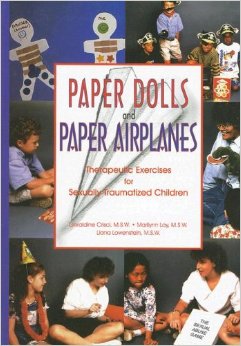Books
Paper Dolls and Paper Airplanes: Therapeutic Exercises for Sexually Traumatized Children
by Geraldine Crisci (Author), Marilynn Lay (Author), Liana Lowenstein (Author)
Paper Dolls and Paper Airplanes is a unique collection of more than 80 activities for mental health professionals working with sexually abused children in individual or group therapy sessions. The activities use paper, crayons, stickers, puppets, music, and other items and are designed to lower the threat level of the treatment process, helping children to heal. Activities are divided into age groups preschool, latency, preteen, and teen to take into account developmental differences, and each activity includes a materials list, directions, and discussion questions.
The book discusses topics such as defining sexual abuse, relationships with family and friends, identifying and coping with feelings, disclosure and documentation, responsibility, personal safety, and self-esteem. Noting that saying goodbye is as important as saying hello, the authors also include information on transitions and graduations.
Paper Dolls and Paper Airplanes provides clinicians with activities and ideas that they can integrate into any sexual abuse treatment framework.
School Curricula
Review:
“The Personal Safety Curriculum is a graduated curriculum for preschool through sixth grade. At each age there are activities to illustrate key concepts. The first concept is the “touch continuum,” based on four components–lack of touch, nurturing touch, confusing touch, and exploitative touch. The “touch” continuum gives children permission to touch and be touched as well as the skills to sort out the difference between good and bad touch. The second component of the curriculum is assertiveness training. Students are taught how to say “No” to potentially exploitative invitations through use of body posture, eye contact, facial expressions, verbalization, and repetition. A third component is “brainstorming” solutions to difficult situations, a process gained by increasing problem-solving and enhancing self-confidence. Included are many “what if” situations on safety. The curriculum is further enhanced by a resource guide to books, films and articles. A pre/post evaluation is also included. “Our initial research shows that over 70% of the kindergarten children understand the concepts and know how to react if approached,” says Crisci. “By second grade, that figure is 80%.”
This is one of the most comprehensive, best researched resources we have fund to date. It is highly recommended to schools and those who consult with schools.”
~ Virginia Child Protection Newsletter (VCPN), Vol. 10, Winter, 1984
Other Publications

